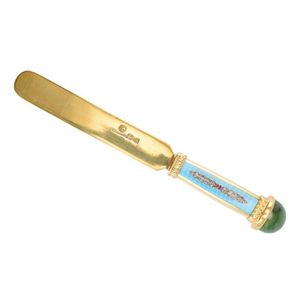Russian Enamelled Letter Opener by Pavel Ovchinnikov, 1890
A Russian silver, gold plated and enamelled letter opener, by Pavel Ovchinnikov, Moscow, circa 1890, the square form handle inset with blue guilloche enamel panel mounted with small rose cut diamonds and ruby cabochon, terminating in a nephrite jade cabochon finial. Struck to blade with maker's mark, assay mark for Anatoly Apollonovich Artsybashev, dated 1890, town mark for Moscow, 84 mark and Imperial warrant granted by Tsar Alexander III. 18.5 cm long, the blade 2 cm wide
You must be a subscriber, and be logged in to view price and dealer details.
Subscribe Now to view actual auction price for this item
When you subscribe, you have the option of setting the currency in which to display prices to $Au, $US, $NZ or Stg.
This item has been sold, and the description, image and price are for reference purposes only.
- Circa - A Latin term meaning 'about', often used in the antique trade to give an approximate date for the piece, usually considered to be five years on either side of the circa year. Thus, circa 1900 means the piece was made about 1900, probably between 1895 and 1905. The expression is sometimes abbreviated to c.1900.
- Assay / Assayed - Assaying is the testing of a metal, most commonly silver and gold to determine its ingredients and quality. In Britain, once an item of silver or gold has been assayed, a mark is stamped on it, certifying its purity. Known as hallmark, it derives its name from the Guild Hall of the Goldsmiths' Company, who recieved its Charter in 1327 giving it the power to assay and mark articles of gold and silver.
- Finial - An architectural decoration, found on the upper parts of of an object. On furniture they are usually found on pediments, canopies and shelf supports. On smaller ceramic or silver items, such as spoons, they may decorate the top of the item itself, or the lid or cover where they provide a useful handle for removal.
Finials have a variety of shapes and forms. They may be urn-shaped, baluster shaped round or spiral, but usually taper into an upper point. Many real life shapes may also be used as finials, such as pineapples, berries, pinecones, buds, lotus and acorns. Sometimes animals such as a lion are depicted, or fish and dolphins. - Guilloche - A form of classical decoration consisting of a repeating ornament of interlacing curved bands, sometimes forming circles, and further decorated with rosettes or other flower forms.
The name is derived from the inventor, French engineer Guillot, who invented a mechanical method of inscribing fine repeating patterns on to metallic surfaces.
On enamelled items with guilloche decoration, the surface is firstly engraved with the repeating pattern, and then covered with several layers of enamel, each of which is fired.
Where the item has not been enamelled the form of decoration is usually called "engine turned".
This item has been included into following indexes:
